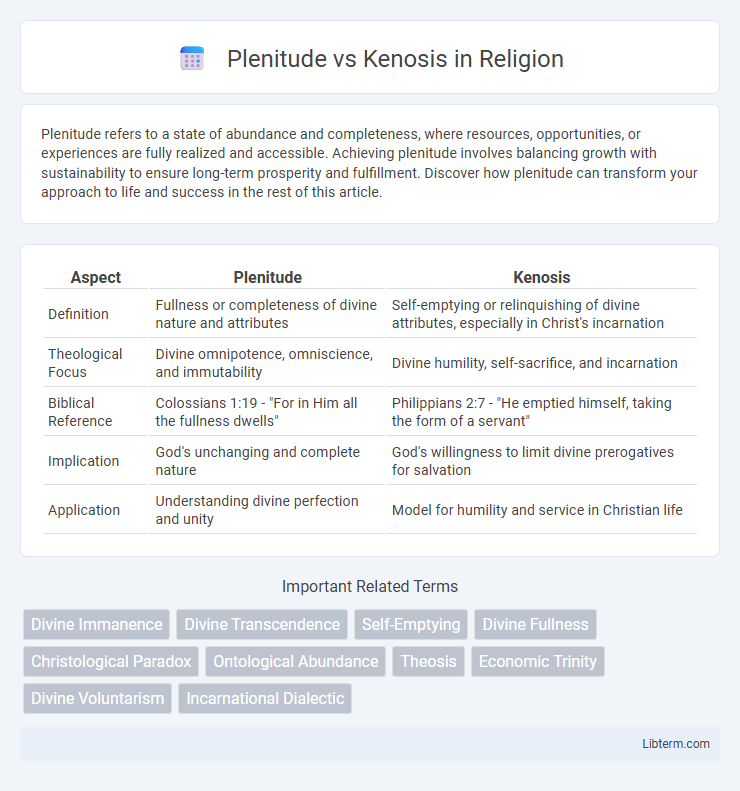Plenitude refers to a state of abundance and completeness, where resources, opportunities, or experiences are fully realized and accessible. Achieving plenitude involves balancing growth with sustainability to ensure long-term prosperity and fulfillment. Discover how plenitude can transform your approach to life and success in the rest of this article.
Table of Comparison
| Aspect | Plenitude | Kenosis |
|---|---|---|
| Definition | Fullness or completeness of divine nature and attributes | Self-emptying or relinquishing of divine attributes, especially in Christ's incarnation |
| Theological Focus | Divine omnipotence, omniscience, and immutability | Divine humility, self-sacrifice, and incarnation |
| Biblical Reference | Colossians 1:19 - "For in Him all the fullness dwells" | Philippians 2:7 - "He emptied himself, taking the form of a servant" |
| Implication | God's unchanging and complete nature | God's willingness to limit divine prerogatives for salvation |
| Application | Understanding divine perfection and unity | Model for humility and service in Christian life |
Understanding Plenitude: The Concept of Divine Fullness
Plenitude refers to the concept of divine fullness, emphasizing the complete and perfect abundance inherent in God's nature and existence. It signifies the totality of divine attributes, such as omnipotence, omniscience, and omnipresence, existing in an inseparable fullness that transcends human comprehension. Understanding plenitude helps clarify theological discussions about God's infinite essence and the manifestation of divine grace and power in the created world.
Kenosis Defined: The Theology of Divine Self-Emptying
Kenosis, derived from the Greek word for "emptying," refers to the theological concept where Jesus Christ voluntarily relinquished divine privileges to fully embrace human limitations. This doctrine emphasizes God's self-emptying as a profound expression of humility and love, central to Christian soteriology and Christology. Kenosis contrasts with plenitude, which denotes the fullness or completeness of divine nature, highlighting the paradox of God's infinite essence choosing to experience finite existence.
Historical Roots: Plenitude and Kenosis in Christian Tradition
Plenitude in Christian tradition traces its roots to early Church Fathers who emphasized the fullness of divine life and grace as revealed in Christ, reflecting the abundant presence of God's nature. Kenosis, derived from Philippians 2:7, historically highlights Christ's self-emptying and humility, shaping theological reflections on the incarnation and divine self-limitation. Both concepts have deeply influenced doctrines on the nature of Christ and the divine-human relationship throughout Christian history.
Philosophical Foundations: Ontology of Abundance and Emptiness
Plenitude and Kenosis represent contrasting ontological paradigms within philosophy, where plenitude denotes an ontology of abundance characterized by fullness, richness, and the multiplicity of being, emphasizing existence as inherently complete and overflowing with potential. Kenosis, by contrast, embodies an ontology of emptiness, centered on self-emptying and reduction, highlighting the dynamic process of relinquishing fullness to allow for transformation, openness, and relationality. These foundations inform metaphysical debates about the nature of being, presence, and absence, challenging static conceptions of existence with complementary notions of fullness and void.
Plenitude in Scripture: Biblical Foundations and Interpretations
Plenitude in Scripture emphasizes the full and abundant presence of God's grace, blessing, and spiritual gifts as foundational to Christian life and theology. Key biblical passages, such as Ephesians 3:19 and John 1:16, highlight the concept of God's fullness dwelling within believers, signifying completeness and divine sufficiency. Theological interpretations stress plenitude as a manifestation of God's infinite nature, contrasting with kenosis, which refers to Christ's self-emptying during the Incarnation.
Kenosis in Scripture: Key Passages and Theological Insights
Kenosis in Scripture is primarily rooted in Philippians 2:5-8, where Christ voluntarily empties Himself, taking the form of a servant to fulfill God's redemptive plan. This self-emptying highlights the paradox of divine humility, revealing a God who relinquishes divine privileges without ceasing to be fully God. Theologically, Kenosis challenges traditional views of omnipotence by emphasizing sacrificial love and servanthood as the essence of divine power and purpose.
Contrasting Plenitude and Kenosis: Paradox or Harmony?
Plenitude embodies the fullness and abundance of divine power, while Kenosis signifies self-emptying and humility, presenting a theological paradox of completeness through emptiness. Contrasting Plenitude and Kenosis reveals a dynamic harmony where divine generosity coexists with self-limitation, challenging conventional notions of power. This interplay underscores a profound spiritual truth that fullness can manifest through self-giving emptiness, enriching Christian doctrine.
Theological Debates: Implications for Christology
Theological debates surrounding plenitude and kenosis profoundly impact Christology by exploring the nature of Christ's divinity and humanity. Plenitude emphasizes the fullness of divine attributes remaining intact in Christ, while kenosis underscores the self-emptying aspect of the incarnation, where Christ relinquishes certain divine privileges. These contrasting views shape interpretations of how Jesus embodies both full divinity and genuine humanity, influencing doctrines on the incarnation and the hypostatic union.
Plenitude and Kenosis in Spiritual Practice
Plenitude in spiritual practice emphasizes embracing fullness, abundance, and the limitless presence of divine energy within oneself, fostering a deep connection to wholeness and vitality. Kenosis, by contrast, involves the conscious act of self-emptying or surrender, allowing practitioners to release ego-driven desires and open space for spiritual growth and divine union. Together, plenitude and kenosis balance spiritual abundance with humble receptivity, guiding individuals toward profound inner transformation.
Contemporary Perspectives: Relevance in Modern Theology
Contemporary theology examines plenitude as the fullness of divine presence and kenosis as God's self-emptying love manifested in Christ, highlighting their dynamic interplay in understanding divine-human relationship. Modern theologians emphasize plenitude to articulate God's omnipresence and sufficiency while interpreting kenosis as a model for self-giving ethics and vulnerability in spiritual life. This ongoing dialogue influences doctrines of incarnation, salvation, and spiritual experience in 21st-century theological discourse.
Plenitude Infographic

 libterm.com
libterm.com